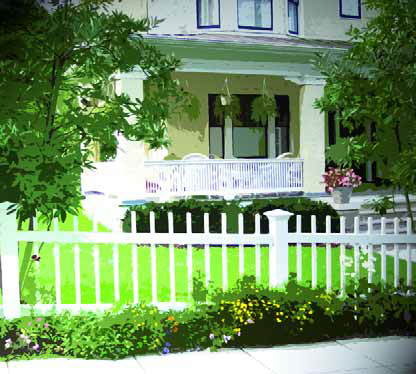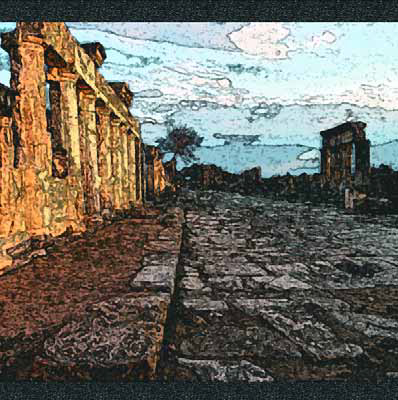architecture
Even though color is literally everywhere, most people know surprisingly little about it. That's a knowledge gap designers in particular should overcome, says artist, colorist and teacher Judith Corona, who adds that understanding the nature of color, how it influences moods and emotions and how a color wheel works are all useful when it comes to making valuable recommendations to clients about their watershapes and landscapes.
Although my practice primarily encompasses residential landscapes, I occasionally tackle a commercial project. In one such case, I was recently asked to design the entry planting and make recommendations for the hardscape at the Riviera Country Club in Pacific Palisades, Calif. One of the most prestigious golf courses in the world, Riviera is the regular host to the Nissan Open, one of the sport's premier tournaments. It's a high-profile site in every conceivable way, so image is everything to the facility's owner and managers. After many years of placing what were essentially band-aids on the entry's landscape, they decided it was time for a complete overhaul and a
It might be something of a cliché, but it's often said that there's great wisdom in being willing and able to learn the lessons of history. In that spirit, I recently took advantage of an opportunity to sit in on a class in the
The goal of a landscape design is to complement a beautifully appointed home with hardscape, plants and other outdoor amenities. Once construction begins, however, reality sets in for many clients and they begin making trade-offs to trim costs and manage the project's bottom line. Most often, cuts like these take their toll on project elements that swing into place toward the end of a project, where the most significant costs tend to be related to larger plants and landscape lighting. Smaller plants can
As the first columnist among several who will be writing in this space, I've been elected to explain what this "Material World" thing is all about. I agree with the editors that it does require some explaining - but not much. The thought is that we in the landshaping business, designers and installer alike, seldom use a single material all on its own. Even a huge, monolithic concrete deck outside a grand office building will have ribbons of stone or brick to break up the monotony. The aim of this and subsequent articles - whoever writes them - is to discuss the process we go through in selecting plant and/or hardscape material combinations that ultimately work together to become beautiful and seemingly effortless explorations of style, texture and color. In other words, we'll be looking at projects for which all the
Our firm has always focused on the creation of watershapes and landscapes for championship-level golf courses. It is work on an enormous scale in beautifully conceived settings, and the clients are extraordinarily demanding. On occasion, our work has reached beyond the links and into the grounds and homes that surround them. That makes sense, because the lion's share of our work on fairways, tees and greens runs parallel to development of adjacent luxury homes. This means that we often expend considerable energy in considering the views from future home sites and the ways our watershapes and landscapes visually interact with what are often
Everywhere you turn these days, you see watershapers tackling projects that would have been unthinkable even a few years ago. It wasn't that long ago that simply raising a spa seemed like a big challenge, but these days vanishing edges, perimeter overflows and other ambitious details have become relatively common. And it's not just technology: Watershapers are gravitating toward great materials, colors, hardscape, plants and amenities - signs of real growth and, for the most part, a very good thing. With this broadening list of possibilities, however, have come some growing pains. The industry's like a teenager with
It's a rare project in which a watershaper has the opportunity to execute a complete design without compromise. In our Scottsdale, Ariz.-based business, we often work with upscale clients on custom pool and spa installations, and it seems that there's always some element or other in the design that ends up being altered or left out. It sometimes reaches the point where we start to feel as though the result, although it may be satisfying to the client, is not fully reflective of our talent, our vision or our best effort. The project pictured in these pages, however, is a dramatic exception to that rule. Although the clients were involved with general suggestions during the design process and construction project, when it came down to details of the plan, they let us go ahead and create an environment that fully reflected our creative vision. They'd seen one of our projects in a local "Street of Dreams" program in which area contractors were selected to build spec homes on the same street in a town just north of Scottdale called Troon. Once the row of home was completed, there were tours, awards and lots of media coverage - quite the high-profile affair. The clients had been in contact with four or five different pool builders in the area, but they'd
It's a truism that almost all contemporary works of art are derivative: The ideas have already been expressed in one way or another at some point in history, and all we can succeed in doing is to apply those enduring forms as creatively as we can. We can't invent the wheel, but we can redraw it, embellish it, place it in context and, in our own ways, improve upon it through the choices we make in using it. To be effective in that sort of downstream effort as watershapers, it is essential that we understand the nature and origins of the basic building blocks of aquatic design. For years, people have asked me where I get my ideas - pools raised out of the ground, the small spillways, the drain details, the modular deck treatments, the color usage and the use of reflection, to name just a few. "Through my design education" is the short answer, of course, but I can get more specific if we





















